#neo-classical elements
Explore tagged Tumblr posts
Text

bmseventh
Jami Ul-Alfar Mosque With Unconventional Color Patterns
Jami Ul-Alfar Mosque, constructed in 1908, is one of the oldest mosques in Colombo, the capital city of Sri Lanka. The structure catches the eye with its distinguished white and red striped exterior. Furthermore, it features a hybrid style finely integrating Gothic Revival and Neo-Classical elements into Indo-Saracenic architecture.

gamze.iremme

gamze.iremme

arjunbutani

inti_traveller

amennyc
#jami ul-alfar mosque#mosque#architecture#colombo#sri lanka#white and red striped exterior#gothic revival#neo-classical elements#indo-saracenic architecture
6 notes
·
View notes
Text
insanity:

proust tell us that in his days, Nerval was though of as a late XVIII writer (yes the influence of diderot and restif is palpable. but…) of pure Gaulish breed, a traditionalist and local painter of idealized and naif french life who couldn’t have in any way been influenced by french romanticism (!!)
#proust adds it would have been better to forget nerval like Sainte Beuve wanted rather than have him be so badly read#he also adds. greek art would have been better forgotten than remembered through the lens of neo classicism#this is what they did to this man who translated goethe at 20. who introduced all foreign lit elements into french romanticism#-proust hyperbolizes- who had such a rich inner world that was mostaken by madness who dueled in dreams. who haunted dark alleys#a mis brazos marcelito#contre sainte veuve tag#pegue proust pegue 👊
13 notes
·
View notes
Text
As much as Brutalist architecture can be cool, I wish the films went with how the Capitol was described in the books; colorful.
All the skyscrapers and streets were bright, clashing colors and while that might look obnoxious on camera, wouldn't that be the point? The yellows are "painful to the eyes," and the "greens too bright." Going with that description, the movie could have shown more of how bizarre the Capitol is compared to District 12.
Brutalist architecture is associated with a lot of Soviet Union-era Europe and what America sees as fascism, which makes sense for the movie and it does look cool. I also think the neo-classical/roman elements were a brilliant addition. I just wish they made it colorful and much more shiny because the Brutalism is too obvious.
Plus, it would add to the dichotomy between how dark the city is, and that just because it's bright and colorful doesn't mean it doesn't have a seedy underbelly.
Brutalism I associated more with D2 and while D2 and the Capitol have close connections, they still have a drastically different world, and showing a difference in architecture could have added to that.
#im rambling about something no one cares about lmao#hunger games#the hunger games#sunrise on the reaping
93 notes
·
View notes
Note
“Your article on how to write and describe indoor spaces was pretty awesome. You found a few notes I sometimes forget to hit like: scent, inherent sounds and ,especially, inherent activity; staff and so forth. Can you do the same outside?ie. facades, architectural features, presence of, or lack of, things like cupolas, balusters, keystone arches, roman vs. ogive-arches. Also distinguish between styles like Neo-Baroque, Neo-classical, Neo-Gothic, etc.?“
Buildings are a really unique way to set the scene. In fact, I’ve read plenty of books where the buildings felt like characters in their own right, rather than just spaces where a story was set. There is so much to gain from being able to capture a building or the architectural style of a region really well, and that goes for both those writing about the same world we inhabit, or if you’re writing genre fiction that requires a completely custom-built world.
Understanding basic architectural elements
Every building is made up of unique details and component parts that come together to give a building its unique, architectural style. When describing a building, or an architectural style, it’s important to have the vocabulary to properly describe what you’re seeing. So here’s a quick primer. The list is by no means exhaustive, but hopefully covers some of the more common architectural elements:
Facade: The main exterior face of a building.
Foundation: The base that supports the structure.
Architrave: This most often refers to the decorative, moulded frame of a door or window.
Cornices: Horizontal decorative moulding at the top of walls.
Skirting: Horizontal decorative moulding at the bottom of walls.
Columns or Pillars: Vertical supporting elements that transmit the force of the elements above to what is below. If these take the form of a female figure, then they are known as caryatids.
Corbel: A bracket-like structural feature designed to hold the weight of what is above it. These are often decorative.
Buttress: A structure built against a wall to prop up or reinforce the wall. Usually these look like flat ramps on the outside of a building, but a flying buttress looks visually like an arch and are used when a building has a vaulted ceiling.
Pilasters: Decorative columns that appear to be embedded in walls that can either be decorative or load-bearing.
Gable: A triangular section of a wall between the sides of a sloped roof.
Pediment: In classical architecture, a triangular gable is called a pediment.
Finial: An object that marks the top, or end, of an architectural element, often used to decorate domes, towers, or gables.
Dormer: A structural element that protrudes vertically from a roof. These offer additional headroom or light into the roof space and can be added to a building post-construction.
Coping: The capping or covering of a wall to give it a finished look.
Cupolas: Small dome-like structures placed on roofs.
Baluster: A small moulded shaft that supports a handrail of a staircase, balcony, or parapet. A series of balusters are called a balustrade.
Arches: Curved structures spanning openings that can support weight.
Moulding: A decorative finishing strip (architrave, cornices, and skirting are all a type of moulding).
Common architectural styles
Architectural styles are incredibly varied, but we tend to talk about only a select few that have been influential internationally, which are often quite Euro-centric. There are lots of incredible styles that are worth your time and research, however I’ve outlined some of the most common styles you may have heard about below so you have an idea of what to look out for:
Baroque: Characterised by highly decorative and theatrical features, the Baroque architectural style originated in Italy during the late 16th century and expanded throughout Europe. Designed to amaze, it used visual and theatrical effects, including domes, painted ceilings, grand staircases, mirrors, sculptures, columns, and oval rooms.
Romanesque: There have been several Romanesque movements, but the first took hold in Europe from the 10th century and the beginning of the 11th century. Characterised by thick walls and bare facades, its interiors were richly decorated with frescoes.
Gothic: Gothic architecture was a popular style in Europe from the late 12th to the 16th century, lasting even longer in some places. The term “Gothic” was first used as an insult during the Renaissance by people who preferred classical designs. Gothic architecture is known for its pointed arches, ribbed vaults, and flying buttresses. It also includes detailed stonework and colourful stained glass windows, making Gothic buildings both elegant and imposing.
Neoclassical: Neoclassical architecture, as the name implies, is a revival of Classical architectural styles, drawing inspiration from Greek and Roman designs. Buildings from the 18th century often resembled Greek and Roman temples. This style is characterised by clean, elegant lines, a simple and uncluttered look, free-standing columns, and large, imposing structures.
Brutalist: Brutalist architecture emerged in the 1950s in the United Kingdom as part of post-war reconstruction efforts. This style is defined by its minimalist approach, emphasising raw building materials and structural elements rather than decorative designs. Brutalist buildings often feature exposed, unpainted concrete or brick, sharp geometric shapes, and a mostly monochromatic colour palette. Steel, timber, and glass are also commonly used in these constructions.
So how do you write it?
Focus on distinctive features
Identify unique architectural elements.
Highlight unusual materials or colours.
Are there any historical modifications that change the look and feel?
Has the building sustained any damage, or is there any wear and tear?
Emphasise scale. Which parts of the building are meant to look large and imposing, and which are more designed to be small and invisible?
Consider the building’s relationship with its surroundings. Does it complement or contrast with neighbouring structures?
What is the building’s function and how does its design serve that purpose?
What is the overall impression or emotional response the building evokes?
Pay attention to lighting, both natural and artificial, and how it interacts with the structure.
Highlight any significant architectural patterns or repetitive elements.
Examine how people interact with and move through the space.
How does it look?
How does the light interact with the building’s surfaces at different times of day and in different weather?
What kind of shadows does it cast, and do these change?
What kind of colour variation is there in the construction?
Are there any distinctive weathering or age marks?
How does the surrounding environment reflect in its windows?
Is there any plant life growing on or around it?
What distinctive architectural patterns stand out?
How does it feel?
What texture does it have? Is it made of stone, brick, wood, or some other more material?
What is the temperature of the surface? Is this in keeping with its surroundings or is this unusual? If so, why?
You can show the passage of time with how smooth certain elements are. Handrails, walls, and steps can all be worn down. Are these elements worn, or crisp and angular?
Are walls smooth or rough to the touch? What does this say about what happens to the building? This could be through the passage of time, exposure to the elements, or the social lives of those who exist in or around it.
Is there any moisture on the walls? Is this expected? What does it say about the general state of repair?
How does the wind and the air move around the building? Are the wind tunnels, or is the air surprisingly still?
How does it sound?
Does sound echo when it bounces off the walls or is it dulled?
What sound does the air make when it interacts with different surfaces?
Does it have any distinctive sounds, like creaking floors or banging pipes?
How do footsteps sound on different surfaces?
Are there any building-specific sounds like the ringing of bell towers or chimes?
Are there natural sounds associated with the building, like the scurrying of insects and small animals on a garden roof?
Research and worldbuilding
Whether you’re writing a fantasy building or describing one in the real world, you’ll probably need to have at least a passing understanding of architectural terms. Your readers have a specific frame of reference, so you need to ensure you use descriptions they can understand. A hobbit hole may be a fictional building, but it is still constructed and described in a way that readers can engage with. With that in mind, these research and worldbuilding techniques will help you on the way:
Research appropriate architectural terms. Don’t get bogged down in details, but make sure you’re using the right word to describe the right thing.
Understand basic construction methods. If you’re writing about real-world buildings, then understanding how they’re built is essential. You don’t want to describe a timber frame in a building that is traditionally constructed with the steel frame. If you’re describing a fantasy building, then you need to have an idea of how these are constructed within the constraints of your story world, and stay consistent. It’s also important to determine if different buildings have different construction. After all, a hobbit hole requires a very different construction from Elrond’s house in Rivendell.
Learn about (or invent) local building materials and determine if they’re used in construction, or if materials are imported.
Consider historical context and regional influences for the buildings you’re describing.
Make sure your building has a function. There’s a difference between describing a specific building, or just using a general description for the style of an area. If you’re being specific, then make sure there’s a reason for that specificity.
Common mistakes to avoid.
Don’t overuse technical terms. When you’ve done the research, it’s natural to want to show off that knowledge, but it’s usually not going to be interesting to readers. It’s important information for you to know so that you can use the right words and means to describe something, but if it’s not plot-relevant, technical jargon isn’t all that useful.
Don’t ignore the human scale. A building is only as useful as the purpose it serves. Never lose sight of the fact that the characters will need to interact with it.
Make sure you remember the environmental context. No building exists in a microcosm, so be sure to fit it into its surroundings.
Don’t overlook a building’s cultural significance. In the grand scale of your narrative, it means something. This could be anything from historical to social. But if the building is important enough to describe, then there are important reasons why it is the way it is.
Remember that buildings are more than just structures; they’re repositories of history, culture, and experience. Your descriptions should capture not just their physical appearance, but their role in the story and their impact on characters and plot.
#writeblr#writing tips#writing advice#writing resources#writers on tumblr#writers#writing#creative writing#writing community#writers of tumblr#creative writers#writing inspiration#writerblr#writer#ask novlr
87 notes
·
View notes
Text
Nevermore is a gothic tragedy. Part II: Supernatural Brides
I had set out to finish this saga of essays before Nevermore came back. And then I realized that all the fucking references I have on hand were going to require at least one essay for each. Which means a total of…at least four parts.
So I made it my goal to finish at least one. And since we're talking about tragedy, it seemed logical to continue with the gothic novel.
Before I start, I have to make a little disclaimer: most of my sources come from Spanish material that I'm not sure I have an English translation because they are loose essays I have from my college days and prologues to books from different publishers that are dedicated to publishing gothic novels. If you understand Spanish, I'll be happy to pass the material on to you if this interests you. But if you only understand English, I'm afraid I only have two sources for you: Supernatural Horror in Literature, an essay by H.P. Lovecraft on the foundations of cosmic horror that reviews the history of horror in fiction and The gothic quest a book of about 400 pages that describes in detail the history of the gothic novel, I hope the density of that work compensates for not being able to deliver more finished information.
Brief (seriously VERY brief) history of the gothic novel
Here is something a bit tangled, because the Gothic novel goes hand in hand with many of the topics of the literature of romanticism (literary movement with which it shares time) and it is also necessary to understand some historical and architectural issues.
Let's go by part: Romanticism is a literary and artistic movement that formally emerged in the second half of the eighteenth century (it is estimated that the first works of the same are dated from 1770, approximately) consisting of three parts: the so-called pre-romanticism, romanticism as such and late romanticism.
Anyway, even from its beginnings, this movement emerges as a series of anti-classical ideas that sought to recover folkloric and medieval elements, were obsessed with the inviduality of creativity, nostalgia for nature (something that would later become nostalgia for the time before the industrial revolution), considered passion and sentimentality as the creative axis and in general were looking to Greek tragedies and other fantastic tales as a source of inspiration.
This clashed with the strong Christian values of the time and the rise of technological advances. A contradiction that is present in the works of this literary movement.
Another important historical fact that is necessary to understand is that this kind of novel gets its name directly from Gothic architecture. These works were intended to take place in castles, monasteries, mansions belonging to ancient families and medieval cemeteries. The reason is simple: the Goths were considered shitty architects and many of these buildings had been abandoned for decades if not centuries by 1700, so you could walk down a path and simply find an ominous monastery or the remains of a mansion and if you asked someone where it had come from, they would probably tell you about 15 different versions, but all involving dead people and ghosts living there. As you may have gathered from the above, the writers of this period were eating this stuff up with fries.
It is with the convergence of all these elements that Horace Walpole's novel The Castle of Otranto was published in 1764. A text born from a nightmare that this man had in the castle of Strawberry Hill, a neo-Gothic property that belonged to him. The novel is mediocre at best, but it lays all the groundwork needed going forward: ominous ancient places full of legends where the crumbling architecture is a reflection of the moral and emotional corruption of the characters.
Feminine entities
One thing in which the Romantics differ from the Gothics is their view of love. In this era, love is perceived as a kind of force that is above the characters, something so beautiful that it is capable of making them completely lose their minds (this is tied to the concept of the sublime. And where the romantics embrace this concept as something beautiful, the goths say “this is fucking disturbing”.
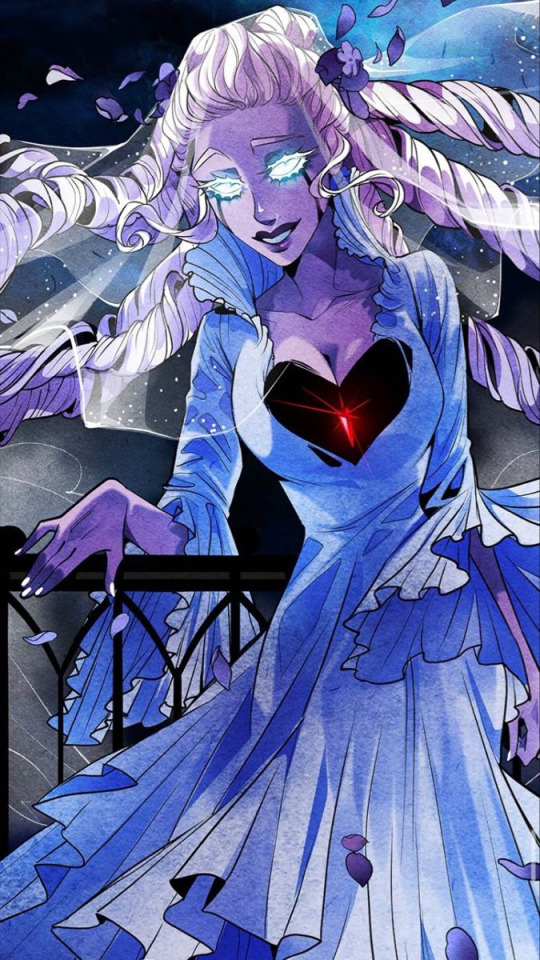
For this reason many gothic stories are up to their necks in supernatural brides: beautiful ghosts dressed in white, beings that we consider references to nymphs who only need to whisper in the ears of their victims to become obsessed with them and, above all, vampires. Vampires whose description you will have in detail because the narrators of these stories spare no words to point out how beautiful they are.
Because these supernatural brides are there for one thing and one thing only: to make our sad male hero lose his mind with the power of their impractically long eyelashes. Sometimes they love them honestly and deeply, sometimes they are insidious, evil and lying; on more than one occasion both alternatives are true at the same time. But the reality of things is that, in the end, the love of these supernatural brides ends up completely destroying the unfortunate object of their affection.
If this seems a bit sexist to you, that's because it is. There's no argument here and it's not worth delving into any further.
I've talked about Annabel as a vampire before, but this time I want to talk more in detail about two issues: how supernatural brides work and the consequences for the protagonist of having a relationship with her and the similarities this story presents to a particular job.
Love and death
What is a ghost? A terrible event doomed to repeat itself over and over again. An instant of pain, perhaps. Something dead that seems at times still alive. A feeling, suspended in time, like a blurred photograph, like an insect trapped in amber. El espinazo del diablo, Guillermo del Toro (original quote in Spanish)
One interesting thing about this whole thing is, too, that while the attitudes of many of these supernatural brides may remind you of variations of a succubus (you know, a female entity that is there for and to seduce), the reality is that the gothic novel is steeped in religious puritanism, so these ladies (most of the time) don't usually need to be sexual with their love interest/victim to get their attention. They usually only need a single glance.
If you think I'm exaggerating:
Never gaze upon a woman, and walk abroad only with eyes ever fixed upon the ground; for however chaste and watchful one may be, the error of a single moment is enough to make one lose eternity.
The dead women in love, Théophile Gautier
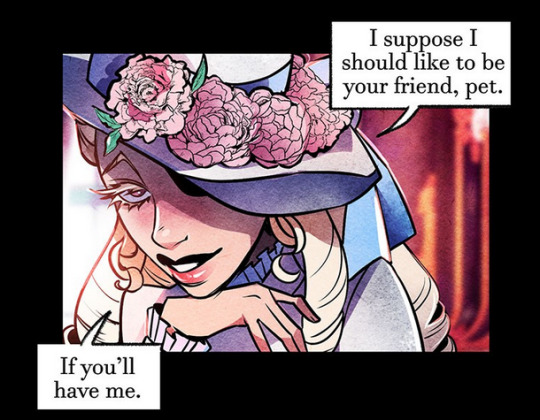

Another thing is that these supernatural brides are usually here at just the right time to skillfully grope the weaknesses of their beloved lover and victim: Are you a feisty guy who thinks he's not afraid of anything? Well, the spirit of the water that will end up bewitching you dwells in a mysterious fountain that no one dares to visit out of fear (Ojos Verdes, Gustavo Adolfo Bécquer ESP/ENG), Have you just obtained eternal life by making a pact with the devil but are a little terrified of what might await you in the solitude of immortality? The beautiful young girl just revived by your own hand has opened her eyes and both you and she know in this one look that you will spend eternity together (The Skeleton Count, or The Vampire Mistress, Elizabeth Caroline Grey), Have you just moved here from Naples and are feeling incredibly lonely? Well, it turns out you have a beautiful neighbor who also seems interested in you. By the way, she's practically a poisonous plant (Rappaccini's Daughter, Nathaniel Hawthorne).
Examples like these are plentiful and most end in three ways for the victim of their affections:
Death.
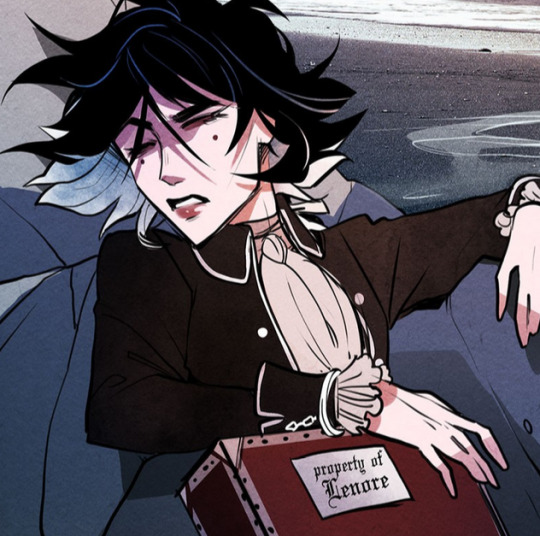
Madness.
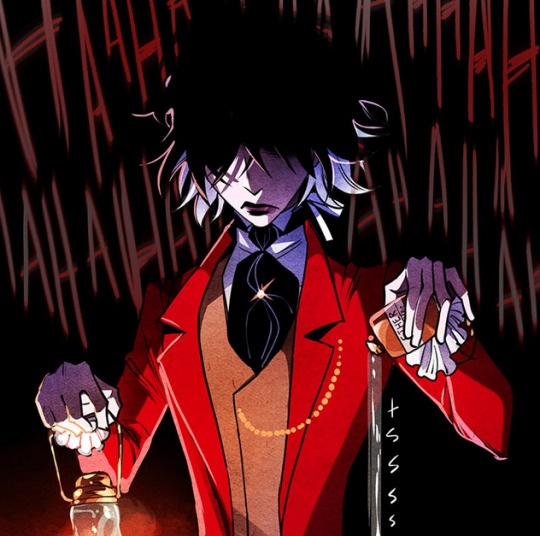
Or eternal mourning for having lost her despite having been a victim of deceit or manipulation.

In Lenore's case, her “supernatural bride” appears after the incident in which she rips the wallpaper off the wall: if flowers symbolize feeling alive, she doesn't need them. There is no need for flowers because she is irreversibly withering away.

And when all seems lost, she receives a visitor.

Annabel is a ghost in Lenore's life. The fuzzy silhouette that represents the one thing that made her happy during her confinement, her last glimmer of sanity in a situation where she could no longer hold on without breaking. A specter whose shadow Lenore has been obsessively chasing since a previous life. And every time she manages to reach her, something snatches her away: Annabel goes back to a place where Lenore cannot reach her with her hands.
This is the sad fate of supernatural bride lovers. Because for the gothic novel, when love transcends death it is not a reason to rejoice: the character's life has been permanently disrupted and all that remains is a feeling that is beyond reason. Love becomes the cruelest and most terrible of punishments.
Carmilla
If you're still here with me and you haven't read Carmilla yet, I highly recommend that you do because if you like goth lesbians, this is exactly your shit.
But just so we're on the same page: Carmilla is a short vampire novel published in 1872 by Sheridan Le Fanu in his collection In a Glass Darkly. The plot is about Laura, a young woman who lives in a proper gothic castle located in Austria and her life will be disrupted with the arrival of a beautiful young woman her age named Carmilla.
Both Lenore and Laura live in almost complete isolation barely accompanied by maids (And, in Laura's case, her father) in a huge estate that is surrounded by an appropriately dense and slightly terrifying forest. Now, the reason they are both here is different: where Lenore is locked up against her will, Laura simply lives in a place that is difficult to access.
But let's make a slightly insidious reading here.
One of the first things we know about Laura is that the maids she lives with, despite being fond of her, consider her “a bit touched in the head” and the incident where Carmilla enters the room when Laura is a little girl is completely dismissed for this reason.
Laura is 19 years old when all this happens and at no point in the play is it mentioned that she has any suitors or intentions of getting married, a bit strange for the time in which it occurs. One would assume that the reason for keeping her so isolated is precisely that Laura's father doesn't think his daughter is particularly sane in the head.
As does Lenore.
Add to that the fact that they are both grieving. Lenore for Theo's death and, in Laura's case, for learning that the daughter of a dear friend of her father's has died in strange circumstances and, although she did not get to know her, this fact affected her a lot.
Anyway, sooner rather than later this almost supernaturally beautiful young lady of her own age shows up and kicks in the door saying she wants to be friends. Carmilla through a carriage “accident” near the property and Annabel requesting a meeting to get to know her.
In both cases, the dynamic established is the same.
On the one hand, we have a young lady who looks completely ecstatic at this pompous and definitely somewhat deranged creature. Laura spares no words in explaining to the reader how fucking beautiful Carmilla is, how important she is to her and how much she loves her. And Lenore, well, Lenore does this:
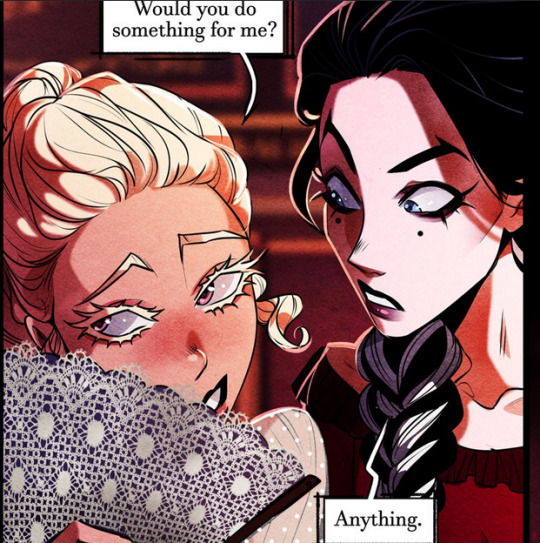
On the other side, the supernatural (girl)friend returns her affection with the subtlety of a kick in the teeth:

Annabel is a little more subtle than Carmilla was before she and Lenore were a thing, but we still see her get super physically close (something she doesn't usually do with other characters in Nevermore, so this is something she only does with Lenore).

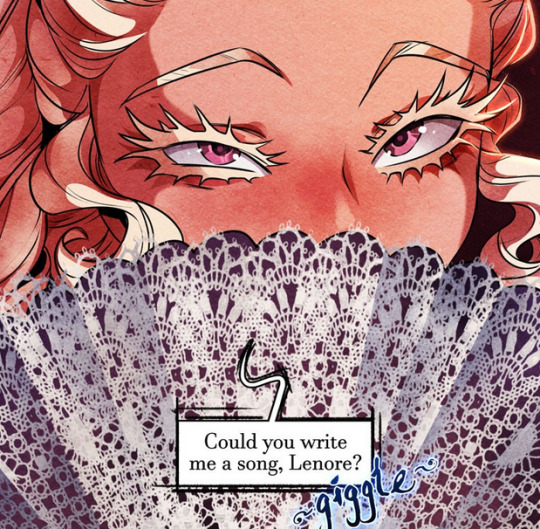
Fun fact: that gesture with the fan means “I'm shy, but I'm interested.”
Unfortunately for our comphet-filled protagonist (because she watches THIS and still thinks they're “good friends”) her days in the company of this girl end in tragedy. Carmilla is eventually unveiled as a vampire and killed, while Lenore sees Annabel leave and, taking into account that they are both in Nevermore, subsequently sees her die.
In both cases, the protagonist's life has been scarred by her supernatural (girl)friend: neither a year-long trip abroad nor a new group of friends can take Laura or Lenore away from the memory of those happy days that are now irretrievably tainted.
Conclusions
I think one thing that has happened to me writing this now that I seriously pulled the rug out from under me regarding the amount of references in this comic and it has been non-stop bullshit. They're all still framed within the genres of tragedy and gothic novel, but even with this essay I've fallen short on some topics.
I don't know when I'll continue with this saga because it really involves going through an awful lot of material, but I can at least say one thing for sure: the amount of detail it has is, honestly, quite impressive.
#nevermore webtoon#annabel lee nevermore#lenore nevermore#lenore vandernacht#annabel lee whitlock#white raven#nevermore webcomic#annabel lee x lenore#lennabel#nevermore
68 notes
·
View notes
Text
Sonic 4 movie. Theories and predictions

Hello everyone! I finally watched Sonic 3, and I can confidently say it was one of the best experiences I’ve ever had in a movie theater! It had been such a long time since I felt so much emotion and joy watching a film. The last time I experienced these feelings was with Michael Bay’s Transformers movies, especially the fourth and fifth installments. Just like back then, when I was super excited for the next movie, I now have the same anticipation for the fourth Sonic movie.
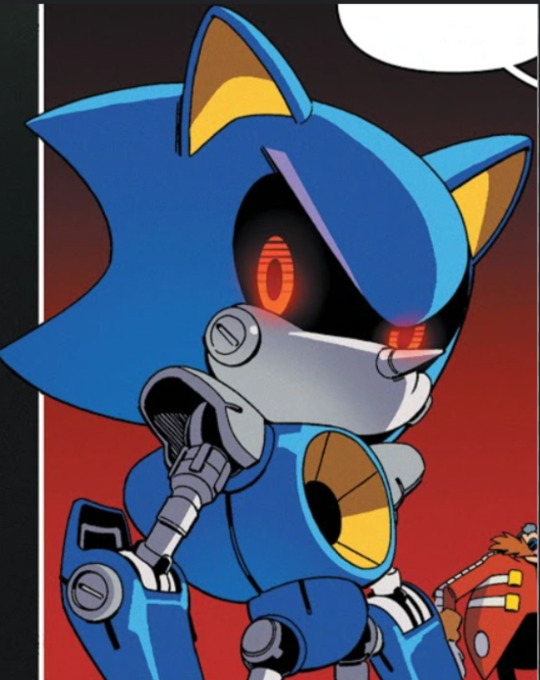
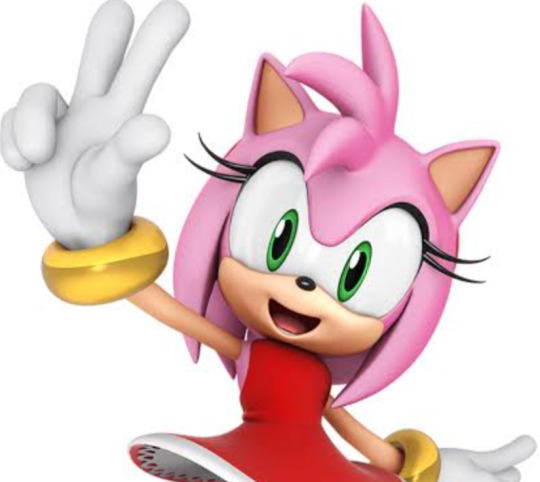
In the post-credits scene, we saw the first appearances of Metal Sonic and Amy, which already gives us a taste of the continuation of the Sonic live-action franchise. That’s why I’d like to share my theory about what might happen in the next movie and which game from the Sonic saga it might adapt.
AND... Just as Sonic 1 was an adaptation of the first classic game, Sonic 2 represented the second game, and Sonic 3 was based on Sonic Adventure 2, I believe the fourth movie will also follow this adaptation formula.
My idea is that the fourth movie will be inspired by two games: Sonic CD, where Metal Sonic makes his first appearance, and Sonic Heroes, where Metal Sonic becomes the main antagonist. In Heroes, he evolves into Neo Metal Sonic and later into Metal Overlord, the final boss. I believe the concept of time travel, central to Sonic CD, could be key to the plot of the next movie.
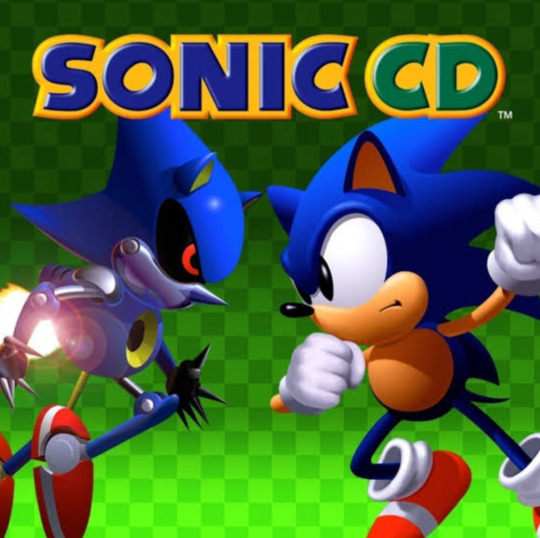
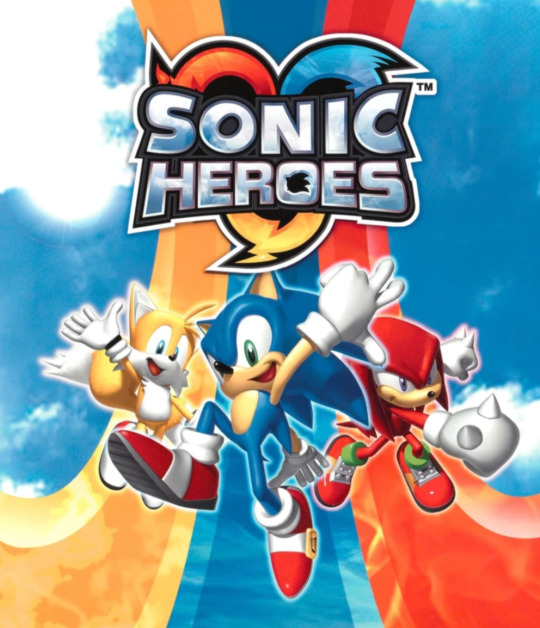
Now, let’s dive into the possible plot of the fourth movie and how the story might unfold.
Probably, Metal Sonic came from the future and returned to the past with the goal of defeating Sonic, driven by frustration at never being able to defeat him definitively. In turn, future Amy, upon discovering Metal Sonic’s plan, decides to also travel to the past to protect him. This could explain the post-credits scene where we see Amy hooded.
This raises some important questions: How did Amy know where Sonic would be, and how did she know who he was? The most logical answer would be that, in the future, Sonic and Amy eventually meet, and she decides to go back in time to save him. Another key point of the potential plot would be the origin of Metal Sonic. After all, who created him, considering that Dr. Eggman died in the ARK explosion in the third movie? While Shadow survived because he’s practically immortal, Eggman is just a regular human, making it extremely unlikely that he escaped.
With that in mind, here are some possibilities regarding Metal Sonic’s creation:
Agent Stone as the Creator:
Stone, loyal to Dr. Eggman, could create Metal Sonic as a way to avenge his mentor’s death. This would continue Stone’s arc, showing how he seeks to keep Eggman’s legacy alive.
G.U.N. and Director Rockwell:
Another possibility is that Director Rockwell, who showed distrust toward Sonic and his team, decides to create Metal Sonic. After the events of the third movie, where the planet was nearly destroyed, she might use Metal Sonic as a weapon to eliminate Sonic, believing that he and his team are too uncontrolled.
Eggman as the Original Creator:
There’s also the possibility that Dr. Eggman created Metal Sonic a long time ago, perhaps after returning to Earth at the beginning of the second movie. However, due to the humiliation he suffered when defeated by Super Sonic, he might have abandoned the use of Metal Sonic and kept the project stored along with other copies. These copies could have been activated later, continuing the storyline.
Any of these options could fit well into the fourth movie’s plot, depending on how the writers choose to proceed with the narrative.
Even though the three movies so far have adapted elements from the game franchise—two from the classics and one from the modern games—they contain many original elements. For example, Sonic’s origin was adapted for the movie, and the story takes place on Earth, not on his home island or planet of origin. Additionally, the Master Emerald wasn’t found on Angel Island but on Earth, and Shadow didn’t live on the ARK in space but also on Earth. So, it’s likely that the fourth movie will also introduce original elements while incorporating important aspects inspired by Sonic CD and Sonic Heroes.
Now, here’s my idea of how the fourth movie’s plot could unfold:
Just like in the second and third movies, Amy could appear after the movie starts, similar to how Tails was introduced in the second movie and Shadow in the third. The movie would likely begin with an introduction to Sonic and his team.
After the boys (Sonic, Tails, and Knuckles) decide to organize another friendly race, Sonic gets too far ahead and ends up in New York City. This becomes even more confusing due to the time difference since he, Knuckles, and Tails live on the other side of the United States with Tom and Maddie. It’s at this point that Metal Sonic and Amy enter, as hinted at in the post-credits scenes.
After Sonic is attacked by Metal Sonic and saved by Amy, he’s full of questions. He wants to know who she is, how she knows his name, and how she knew where to find him. His questions are similar to those he asked Knuckles and Tails when he met them. Amy then explains that she came from the future to help him defeat Metal Sonic once and for all.
With no other choice, Sonic decides to take Amy home. There, he introduces her to the rest of the team, and they begin discussing what’s happening. Amy explains that she came from the future to warn him about Metal Sonic and save him. She details Metal Sonic’s origin, explaining that he’s after Sonic to defeat him once and for all since he couldn’t win in the future. That’s why she followed him to the past, both to warn Sonic and help him in his mission.
With this information, Sonic, Tails, Knuckles, and Amy decide to form a team to face Metal Sonic. However, upon realizing that their enemy is extremely powerful, Sonic concludes that the only way to defeat him is by using the Master Emerald again to transform into his Super form and destroy him once and for all.
However, there’s a problem: at the end of the last movie, Sonic 3, Sonic lost his Super form while preventing a global catastrophe. During that moment, Shadow was also in his Super form but stayed behind after the final explosion. This caused the Chaos Emeralds to scatter across Earth due to the impact. Now, Team Sonic must gather the Emeralds again to have any chance against Metal Sonic.
Meanwhile, G.U.N. also steps in. After the events of the third movie, the organization begins questioning how Sonic and Shadow were able to prevent such a large-scale catastrophe. They eventually discover the existence of the Chaos Emeralds and, upon understanding their immense power, decide to locate them to keep them "safe." After all, the Master Emerald is seen as an extremely dangerous weapon, capable of turning a person into something close to a god.

This is where Rouge enters the story. As a G.U.N. spy, she’s sent to locate the Chaos Emeralds before Team Sonic. This sets up a race between both sides: Team Sonic needs the Emeralds to save the world and defeat Metal Sonic, while G.U.N. wants to capture them to prevent them from falling into the wrong hands (even though, for Sonic, that includes themselves).
This intense competition between Sonic and his team against G.U.N. adds a layer of tension and urgency to the film, especially since both sides have legitimate motivations for wanting the Emeralds. However, G.U.N.’s belief that Team Sonic isn’t trustworthy might spark conflicts and tense moments between them.

During this race to recover the Chaos Emeralds, Metal Sonic comes into play. He ends up encountering both sides—Team Sonic and G.U.N.—leading to a major battle among everyone, adding more tension to the plot. At this point, Shadow, who still holds a grudge against G.U.N. for what they did to Maria, temporarily joins Team Sonic. His main motivation is to prevent G.U.N. from keeping the Chaos Emeralds, as he believes the organization doesn’t deserve that power.
Since Shadow has a direct connection to Chaos energy, similar to what we saw in Sonic Heroes, Metal Sonic manages to obtain one of Shadow’s quills. He uses the power contained in it to amplify his abilities and eventually evolves into Neo Metal Sonic. By combining Shadow’s power with the Chaos Emeralds, Metal Sonic reaches his final form: Metal Overlord, the final boss in Sonic Heroes.
However, before this happens, G.U.N. manages to capture the Chaos Emeralds, putting them temporarily ahead in the race. At this moment, Rouge, true to her nature as a jewel thief, betrays G.U.N. She steals the Emeralds, but her escape doesn’t go as planned. She soon realizes the situation becomes critical when Metal Sonic, now more powerful, begins transforming into his primitive forms, leaving a trail of destruction in his wake.

Seeing no other choice and recognizing that Team Sonic is the only hope to defeat Metal Sonic, Rouge hands over the Chaos Emeralds to them. With the Emeralds in hand, Team Sonic activates the Master Emerald’s power, allowing Sonic to once again transform into his Super form. With this power, Sonic faces Metal Overlord in an epic final battle.

Shadow’s role at this moment remains uncertain. He might join Sonic in his Super form, as he did at the end of Sonic Adventure 2 and Sonic Heroes, or he might choose not to intervene directly. Regardless, this battle serves as a major climax for the film, bringing both classic and original elements to the story.
Although the previous films have adapted elements from the games, they’ve also added their own unique ideas, and it’s likely the fourth film will follow the same trend. The movie universe, after all, is separate from the games’ universe, giving the writers creative freedom to develop new stories and explore different dynamics between the characters.
Regarding Shadow’s presence in the fourth film, I believe he’ll play a key role, as his connection to Chaos energy is crucial for Metal Sonic’s transformation into Metal Overlord. Shadow’s involvement would also be an opportunity to further explore his relationship with his past and G.U.N., as well as strengthen the dynamics within the movie universe.
Introducing Rouge, hired by G.U.N. to steal the Chaos Emeralds, would be an excellent way to bring the character into the cinematic universe. This initial role, where she infiltrates as a spy and later betrays G.U.N., demonstrates her cunning and independence while establishing her motivations. By the end of the movie, Rouge could team up with Shadow and Agent Stone to form the famous Team Dark, opening doors for future storylines.
As for Omega, his introduction would be a bit more complicated. However, one possibility could be Agent Stone reactivating one of Dr. Eggman’s old robots, as Omega was originally created by Eggman to serve as a guardian and companion. This idea would fit well with the theme of reclaiming Eggman’s legacy in the movie, but his presence would need to be carefully balanced to avoid overwhelming the story.
Introducing too many characters in the fourth movie could be a challenge. While it’s exciting to expand the cast, it’s essential to keep the story’s main focus: the showdown between Metal Sonic and Sonic. In the first three movies, new characters were introduced in a balanced way, always keeping Sonic at the center. This balance ensured that Sonic’s protagonism remained intact, even with the addition of significant figures like Tails, Knuckles, and Shadow.
Therefore, while Rouge and Shadow’s presence seems essential, adding more characters like Omega could be challenging without diverting attention from the main plot. It’s important that the movie continues to highlight Sonic as the main hero, ensuring that new additions complement the story rather than overwhelm it.
The dynamic between Sonic and Amy in the fourth movie could indeed follow a friendship and camaraderie approach, similar to what we saw in the Super Mario Bros. animated movie. Just as they portrayed Princess Peach as a strong and independent warrior alongside Mario, Amy could be presented as a powerful and strategically important ally, without forcing a romantic relationship between her and Sonic.
Although Amy is traditionally Sonic’s romantic partner in the games and series, SEGA has already clarified that their relationship isn’t canon. This decision reinforces the creative freedom to adapt the character in the cinematic universe while maintaining the individuality of both characters. Sonic, with his adventurous and carefree personality, would hardly fit into a romantic role in the movies, as it could shift focus from his journey as the protagonist.
In the movie, Amy could be presented as someone who shares the same goals as Sonic, fighting alongside him and his team against threats like Metal Sonic. The post-credits scene of the third movie already gave us a glimpse of her combat skills and confidence, highlighting her iconic hammer as her weapon. This suggests her presence in the fourth movie will be more as a warrior and strategic ally rather than a character dependent on Sonic or hopelessly in love with him.
This approach also creates a more modern and inclusive dynamic for the audience, showing that a female character can be equally strong and independent without being defined by a romantic relationship. A deep friendship and mutual respect between Sonic and Amy could strengthen the development of both characters while maintaining the adventurous and lighthearted tone that characterizes the franchise.

Finally, let’s talk about the possible post-credits scenes of the fourth movie, which always leave clues for the next chapter in the franchise. Since it’s been confirmed that the fourth movie won’t be the last—the idea is to create a quintology (five movies) and not a sextology—it’s very likely that the post-credits scenes of the fourth movie will introduce a new character or hint at the plot of the next movie.
One of the strongest speculations among fans is the possible appearance of Silver the Hedgehog in the post-credits scenes. This would make perfect sense since Silver is a central character in the Sonic the Hedgehog 2006 game, whose storyline revolves around time travel. Just as Amy and Metal Sonic are essential to the plot of the fourth movie, introducing Silver in the post-credits scenes would be the perfect bridge to address the plot of Sonic 2006 in the fifth movie.
Silver could appear from the future, on a mission to alter past events to save the chaotic future he came from. His arrival would bring new dynamics to the story and expand the Sonic cinematic universe, exploring themes like fighting to change destiny and the challenges of time travel.
However, I prefer not to delve into theories for the fifth movie just yet, as the fourth movie hasn’t even been released. I think it’s better to wait for the official release of the fourth movie to understand the clues they’ll leave behind and then develop more solid theories about what to expect in the fifth film.
And that’s it, everyone! This is my theory for the fourth Sonic movie. I know some ideas might seem a bit out of the box, but as we’ve seen in the first three movies, they don’t exactly follow the stories from the games. There are many original additions and changes to fit the Sonic universe into the cinematic narrative, and I believe the same will happen in the next film.
If you’ve read this far, thank you for reading my theory! Now I’d like to know your opinion: what do you think might happen in the fourth movie? Share your ideas, and let’s keep this conversation going! :)
#sonic#sonic the hedgehog#sonic movie 3#sonic movie universe#sonic movie spoilers#sonic movie 4#shadow#shadow the hedgehog#rouge#rouge the bat#agent stone#amy rose#silver#silver the hedgehog#sonic theory
77 notes
·
View notes
Text
About this blog!!
Hi! This is a sideblog for me to dump posts that remind me of Eureka: Investigative Urban Fantasy, an excellent system for tabletop mystery games developed by @anim-ttrpgs. Below the cut is information about Eureka, its creators, myself, and what to expect out of this blog.
What is Eureka?
Eureka: Investigative Urban Fantasy is an indie tabletop roleplaying game by the very talented team at @anim-ttrpgs, focused on providing mechanical support for stories where characters investigate mysteries, as well as allowing for the presence of supernatural phenomena and characters. In my opinion, it is the most elegant, cohesive, and interesting TTRPG system that I have ever read or played in terms of its mechanics, storytelling capabilities, and even its perspectives on society as a whole. This blog is, more or less, "propaganda" convincing people to give the game a shot – I'm not affiliated with its creators in any way other than being acquainted with them through their work and online communities, but I love the game and its community, and I'd love to see it succeed, so I want to share an idea of what it is and why I like it.
What makes Eureka such a great system?
A whole lot! Its systems are deeply elegant, creating a game where players can piece together mysteries alongside their investigators in a grounded world that still leaves space for supernatural intrigue. Combat is swift and strategic, but deadly if you go in without a plan. Investigations can be complex, but even the stickiest of situations don't require railroading to keep players on track. Mundane and supernatural characters alike have access to unique abilities, quirks, and skills that make each character feel distinct in mechanics as much as in flavor. The game interacts with the real world by way of fiction in a way that's refreshing and endlessly fascinating.
Systems like Eureka! moments (which allow investigators to retroactively learn information from a previously failed roll) and the streamlined character creation system allow the game to run smoothly and efficiently without getting overly bogged down, and mechanics like the Composure meter (representing an investigator's energy level and state of mind) and the Success/Partial Success/Failure resolution mechanic create an interesting element of risk where player choices matter a lot.
On top of all that, Eureka includes rules for supernatural characters that beautifully integrate the themes, traits, and abilities of classic folkloric or media monsters, making for intriguing secrets, hard choices, and a lot of variety in the gameplay of different investigators. (Most of this is already true of mundane non-supernatural characters, but it's carried through into the lens of vampires and other monsters very elegantly.)
I'd love to see the tabletop gaming scene as a whole take notes from Eureka's handling of a lot of different problems, and I'm constantly excited to see what their team comes up with next. If you ever want to run a mystery story in a tabletop game (especially if systems like D&D 5e have disappointed you on that front), I would seriously recommend Eureka as the game to use for that purpose, and if you're interested in the hobby at all, I would recommend reading Eureka as a way to get valuable insight into the thought process that goes into game design in the tabletop space.
What can I expect to see on this blog?
This blog is for basically any post I see that makes me think of Eureka. Most of the time, that includes references to the monsters and phenomena referenced in the rules about supernatural characters – posts about vampires, werewolves, witches, and alien shapeshifters, for example, are often right at home here. In particular, posts about these kinds of supernatural beings being normal people and living normal lives tend to remind me of Eureka. Other things that are reminiscent of Eureka include noir and neo-noir aesthetics, which the game owes a lot to, and popular detective media, which is ultimately its core inspiration.
Who runs this blog?
I'm Nora, my main blog is @mc-cookies, and I am just a fan of Eureka. I'm not directly affiliated with the creators (hell, they don't remotely have the budget to make me advertise for them), but they and the rest of the community are super nice people who have a lot of insight about the process of making and playing tabletop games.
Who makes Eureka, and how do I support them?
Eureka is an amazing game, and independent tabletop designers across the board do a ton of work to make art that I enjoy a lot, but unfortunately it's not the most welcoming market to be in. Wizards of the Coast, and by extension Hasbro, has what is effectively a monopoly on the TTRPG hobby in the form of D&D, and it's hard for new creators to break into the space because of that. Eureka is made by ANIM TTRPGs, a very small group of designers taking on a very large project. While they're gearing up for the full release of Eureka and preparing their next projects, any support is helpful to them.
To read Eureka, visit their itch.io page to download a fully playable beta version on a pay-what-you-can basis! Even free downloads can support the game by bumping Eureka on itch's algorithm and getting it recommended to more people.
To support ANIM more, consider subscribing to their Patreon, which will grant you access to more frequent updates of the Eureka beta, as well as concept art, previews of their future projects, and a community discord server.
To give on a one-time basis, use ANIM's ko-fi page to donate to them more directly. Right now they're also taking donations to add custom characters into the rulebook as possible random encounters, and ko-fi is the place to go for that!
If you just want to interact with the team at ANIM and learn more about the work that they're doing, give them a follow here on tumblr at @anim-ttrpgs – their blog has similar content to this one, as well as regularly posting excerpts of the rules, answering people's questions, and discussing the broader tabletop gaming hobby.
And last but certainly not least, ANIM also runs a TTRPG Book Club server on Discord, which is excellent for finding RPGs to read and play and people to read and play them with, and is a great place to interact with other people who are interested in indie TTRPGs (including ANIM's staff and other fans of their work).
What's the deal with your avatar?
That is a "snoop", a stylized human figure serving as the mascot of Eureka! Designed by @theblackwarden, these little guys appear throughout the rulebook to graphically represent various mechanics, and they're very fun designs. This one, in particular, represents the "anime wolfgirl", which is a humanoid form that wolfman (aka "loup-garou" or "Hollywood werewolf") investigators can take, reserving only their ears, tails, and claws.
I have more questions!
My ask box is open! Have fun checking out the other posts around this blog :)
40 notes
·
View notes
Text
Architectural styles I associate with each District
*I am American and I think that comes thru in this but Panem is in America so i don't really care. Styles below the cut

💎 District 1 ~ Haussmannian

⚒️ District 2 ~ Neo-Classical

⚙️ District 3 ~ Prairie School

🎣 District 4 ~ Mediterranean Revival

🔌 District 5 ~ Art Deco

🚃 District 6 ~ Mid-Century Modern

🪵 District 7 ~ American Craftsman

🧵 District 8 ~ Edwardian

🍞 District 9 ~ Carpenter Gothic

🐮 District 10 ~ Western False Front

🚜 District 11 ~ American Southern
*not technically an actual architecture style just a collection of building elements that are associated with the american south

⛏️ District 12 ~ American Colonial
65 notes
·
View notes
Text
100 Movies and TV Shows That Are All About Tarot Magic! 🔮✨📺

Movies
The Hunger Games (2012) - Katniss’s journey is like a tarot reading on steroids; choices and fate collide in a dystopian arena where survival is everything. 🎯
The Craft (1996) - A classic teen witch flick where tarot helps our girls explore their powers and the messy side of friendships. ⚡🧙♀️
The Matrix (1999) - Think of it as a giant tarot deck—Neo’s choices determine his fate in this mind-bending reality. 🕶️💊
Live and Let Die (1973) - Bond's tarot experience gives him the edge to outsmart villains; it's all about fate and danger, baby! 🔫🃏
The Devil's Advocate (1997) - The ultimate battle of good vs. evil, with tarot adding layers of temptation and deception to the mix. 😈⚖️
The Mummy Returns (2001) - Who knew tarot could be a map to ancient magic? This adventure intertwines destiny with mystical fun. 🏺✨
The Dead Zone (1983) - A guy wakes up from a coma with psychic powers—basically a walking tarot deck revealing tragedies. 🥴🔮
The Gift (2000) - A psychic woman using tarot to solve a murder? Yes, please! The cards are a game changer for uncovering dark secrets. 🕵️♀️🖤
The Love Witch (2016) - Tarot is the ultimate love compass in this enchanting quest for romance; it’s a spellbinding ride. 💖🔮
The House of the Devil (2009) - Tarot cards hint at some seriously creepy stuff in this horror flick—just don’t ignore the signs! 👻🃏
The Witches of Eastwick (1987) - Witchy shenanigans are afoot! Tarot helps the ladies navigate their newfound powers in style. 🧙♀️✨
The Skeleton Key (2005) - Tarot adds a twist to this supernatural thriller, hinting at fate and transformation along the way. 🔑👻
The Tarot Card Mystery (1935) - A vintage mystery where tarot cards reveal secrets—definitely ahead of its time! 🃏🔍
The Witch (2015) - A haunting exploration of fear and isolation, with themes echoing tarot’s focus on the unknown. 🌌😱
The Sorcerer’s Apprentice (2010) - Magic meets fate in this fun adventure; think of it as a magical tarot experience! ⚡️🧙
The Haunted Mansion (2003) - Tarot cards pop up as quirky tools to navigate spooky secrets—who doesn’t love a ghostly adventure? 👻🏰
The Seventh Seal (1957) - A classic that dives deep into mortality and fate, reminiscent of tarot’s existential vibes. ⚔️🕊️
The Brothers Bloom (2008) - Tarot elements add complexity to sibling dynamics; it’s all about finding purpose in the chaos. 🃏💔
The Final Destination (2000) - If that ain’t a tarot-inspired fate, I don’t know what is! Choices lead to some wild outcomes in this thriller. 💀🎲
The Girl with the Dragon Tattoo (2011) - Dark secrets are unearthed, much like the revelations from a tarot reading. Intriguing, right? 🔍🖤
The Rites of Spring (2011) - A horror flick that vibes with sacrifice and fate, echoing the symbolism found in tarot cards. 🌱🔪
The Man Who Knew Too Much (1956) - Tension and unpredictability—this plot screams tarot vibes as life’s mysteries unfold. 🎭🔎
The Illusionist (2006) - A magician’s journey that parallels tarot’s mystical essence as he navigates love and fate. 🎩💫
The Others (2001) - Creepy atmosphere and hidden truths? Yep, tarot’s got that covered, too! 👻🔮
The Craft: Legacy (2020) - A fresh take on the original that dives into friendship and power through the lens of tarot and witchcraft. 🔮✨
The Fifth Element (1997) - This sci-fi classic combines magic and fate with a dash of humor; it’s like a cosmic tarot reading! 🚀💥
The Lovely Bones (2009) - A supernatural tale where tarot-like elements hint at the unseen and the unknown. 🌌🕊️
The Skeleton Twins (2014) - A dark comedy that touches on fate and family dynamics, echoing tarot’s complex themes. 🎭💔
The Secret of Roan Inish (1994) - Folklore meets mystery; the film explores themes of fate that resonate with tarot’s storytelling. 🏝️🐬
The Last Witch Hunter (2015) - Vin Diesel vs. witches with a side of tarot magic? Count me in! ⚔️🔮
The Psychic (1978) - This film dives deep into the world of psychic phenomena, showcasing tarot as a vital element. 🔮👁️
The Circle (2017) - A social media thriller where hidden truths emerge, similar to what tarot often reveals. 📱🔍
The Lady in White (1988) - A ghost story intertwined with mystery and fate, echoing the essence of tarot. 👻💔
The Stars Are Right (2016) - A quirky indie film that explores fate and destiny, capturing the spirit of tarot. 🌌✨
The Cat's Meow (2001) - A mysterious film where tarot serves as a lens through which the story unfolds. 🎩🔮
The Amityville Horror (1979) - Ghostly encounters hint at fate and the unknown, reminiscent of tarot's spooky vibes. 🏠👻
The Talented Mr. Ripley (1999) - Themes of identity and fate intertwine, much like a complex tarot spread. 🎭🔪
The Cabin in the Woods (2011) - A meta-horror film that plays with fate and choices, echoing the unpredictability of tarot readings. 🏕️🔮
The Golem (2018) - A mystical tale that explores themes of creation and fate through the lens of folklore. 🏺🌌
The Tenth Victim (1965) - A blend of sci-fi and existential themes, featuring fate and choices akin to tarot narratives. 🎯🔮
The Last House on the Left (1972) - A horror classic where fate and revenge intertwine, reminiscent of a dark tarot reading. 🔪😱
The Uninvited (2009) - A supernatural thriller that hints at hidden truths and fate, paralleling tarot’s revelations. 🏠👻
The Beloved (2002) - A haunting exploration of love and loss, echoing tarot's complex emotional landscapes. 💔🔮
The Dreamers (2003) - A film that dives into identity and choice, echoing the themes found in tarot readings. 🌙✨
The Giver (2014) - Themes of choice and fate resonate in this adaptation, mirroring the insights tarot can provide. 📚🔮
The Stendhal Syndrome (1996) - A psychological thriller exploring identity and fate, akin to the symbolism in tarot. 🎨🌀
The Inheritance (2020) - A suspenseful tale where family secrets unravel, showcasing tarot’s ability to reveal hidden truths. 🏡🔍
The Illumination of the Heart (2021) - A story of self-discovery and fate that resonates with tarot's themes. 💖🔮
The Shadow of the Wind (2021) - This adaptation plays with themes of fate and discovery, much like a tarot reading. 📖✨
The Tenth Victim (1965) - A blend of sci-fi and existential themes, featuring fate and choices akin to tarot narratives. 🎯🔮
TV Series
Buffy the Vampire Slayer - Buffy’s journey often mirrors tarot themes of fate and choice, especially with her supernatural challenges. 🧛♀️🃏
True Detective - Dark and atmospheric, tarot-like symbolism underscores the show’s exploration of fate and morality. 🌌🔍
The Simpsons - Tarot pops up in humorous moments, revealing the show’s clever take on destiny and future events. 😂🔮
Charmed - Sister witches often use tarot to guide their magical choices and navigate personal dilemmas. 🌟🧙♀️
American Horror Story: Coven - The use of tarot enhances the show’s dark themes, revealing secrets and fate in the world of witches. 🔮👻
Supernatural - The Winchesters encounter tarot in their monster-hunting adventures, adding depth to their supernatural quests. 👬🔪
The Chilling Adventures of Sabrina - Tarot plays a significant role as Sabrina navigates the complexities of magic and destiny. 🧙♀️🖤
Psychic Detectives - This series highlights real-life psychic detectives using tarot and intuition to solve crimes. 🔍🔮
The OA - The show’s exploration of alternate realities and fate resonates with tarot's deeper meanings. 🌌✨
The Twilight Zone - Various episodes reflect on fate and the unexpected, echoing tarot's insights into human nature. 🌠🌀
Once Upon a Time - The blend of fairy tales and fate often hints at tarot-like themes throughout the series. 📖✨
The Good Place - Philosophical discussions about morality and choice parallel the insights gained from tarot readings. 😇💭
Castle - The detective duo sometimes turns to tarot for insights into their cases, blending humor and mystery. 🔍📚
Dark Shadows - The gothic series often intertwines themes of fate and supernatural elements akin to tarot. 🌙🦇
Twin Peaks - The series’ exploration of dreams and hidden truths resonates with the mystique of tarot readings. 🌌👁️
The Simpsons - Tarot gets a playful nod in various episodes, reflecting the show’s irreverent humor about fate. 😂🃏
Shadowhunters - The characters explore destiny and choice in a world filled with supernatural elements, echoing tarot themes. 🌌🗡️
The Secret Life of the American Teenager - Characters often face choices that mirror the dilemmas found in tarot readings. 🏫💔
The Sopranos - Characters navigate fate and morality, exploring themes that resonate with tarot’s insights. 🔫💭
The Expanse - Choices and destinies intertwine in this sci-fi epic, mirroring the complexity of a tarot spread. 🚀🔮
The Haunting of Hill House - Themes of grief and fate resonate deeply, akin to the revelations found in tarot readings. 👻💔
The Mentalist - The protagonist’s observational skills often mirror the insights one might gain from tarot. 🕵️♂️🔮
The Umbrella Academy - Themes of family, fate, and destiny play out in wild ways, much like a tarot deck in action. 🌈🦸♂️
The Vampire Diaries - Characters often face choices that echo the dilemmas and fates seen in tarot readings. 🧛♀️💔
The Blacklist - The use of intuition and uncovering secrets parallels the insights gained from tarot. 🕵️♀️🔍
The Office - Tarot makes a quirky appearance, offering a humorous take on fate and decision-making. 😂📋
The Simpsons - Tarot gets a playful nod in various episodes, reflecting the show’s irreverent humor about fate. 😂🃏
The Big Bang Theory - Characters often joke about tarot, providing comedic insights into fate and decisions. 🧑🔬🎲
The X-Files - Paranormal elements and investigations often touch on themes akin to tarot’s mysteries. 👽🔍
The West Wing - Political decisions and moral dilemmas resonate with themes found in tarot readings. 🏛️💭
The Good Wife - Legal battles and ethical choices reflect the complexities of fate and decision-making, much like tarot. ⚖️💔
The Middle - Everyday choices in family life often resonate with the relatable dilemmas seen in tarot spreads. 🏠💖
The Secret Life of the American Teenager - Characters face life-altering decisions that echo the themes found in tarot readings. 🏫💔
The Affair - Complex relationships and moral choices explore themes of fate that resonate with tarot’s insights. 🌊💔
The Good Fight - Legal drama intertwined with moral complexities, showcasing themes of fate and choice akin to tarot. ⚖️🔮
The Amazing Race - Contestants face challenges that mirror the unpredictability of tarot readings and fate. 🌍🏃♂️
The Neighborhood - Light-hearted comedy that often touches on fate and friendship, echoing themes found in tarot. 🏡💖
The Big Bang Theory - Characters explore humor and fate, providing a light-hearted take on tarot’s deeper meanings. 🎲😂
The Goldbergs - Family dynamics and nostalgic themes often resonate with relatable dilemmas seen in tarot readings. 🏠💖
The Resident - Medical dramas often explore moral dilemmas, reflecting the complexity of choices found in tarot. 🏥💔
The Good Place - Philosophical discussions about morality and choice mirror insights gained from tarot readings. 😇💭
The Wonder Years - A nostalgic exploration of life’s choices and fate, echoing the themes seen in tarot. 🌼💭
The Flash - Time travel and choices intertwine, reflecting themes of fate and destiny akin to tarot narratives. ⚡🕒
The Last Man on Earth - A humorous take on survival and fate in a post-apocalyptic world, echoing the themes found in tarot. 🌍😂
The Fall - A psychological thriller where the interplay of fate and morality resonates with tarot’s deeper meanings. 🕵️♀️💔
The Expanse - A complex narrative where fate and choices intertwine, much like a tarot spread. 🌌🔮
The Haunting of Hill House - A deep exploration of grief and fate, paralleling the revelations often found in tarot readings. 👻💔
The 100 - Survival and moral choices mirror the complex themes seen in tarot readings. 🌍🔪
The Mandalorian - Destiny and choice play significant roles as characters navigate a galaxy filled with uncertainty, echoing tarot’s themes. 🌌⚔️
The Walking Dead - The show dives into choices and fate in a post-apocalyptic world, reflecting the unpredictability of tarot. 🧟♂️🔮
#divination#psychic#tarot reading#free readings#paid tarot readings#paid readings#free tarot#daily tarot#tarot community#tarotblr#tarot cards#tarot#future spouse#astrology#spirituality#crystals#witchcraft#meditation#manifestation#witchblr#spiritual awakening#mysticism#numerology#occult#wicca#pick a card#pick a pile#paranormal#tarot witch
44 notes
·
View notes
Note
1, 4, 6 for the fic of your choice with that writer ask meme!
i am going to do the rapture of that cruelty which yet is love as the fic for which these questions are most applicable!
1. Start to finish, how long did it take to plan and write? Did you take breaks during the process?
this was for a reverse bang, and i claimed my artwork sometime in august. i had a false start - i was originally going to do a modern AU that was kind of a “sharp objects but if amma was the marian and actually became a vampire when she “died”” type deal. without the munchausen’s mommy, but the general vibe of unsettling pubescent sexuality, girls vulnerable to predation turned the predator, etc. but it wasn’t gelling, and then i reread carmilla and decided to do a neo-victorian epistolary frame narrative gothic pastiche instead. i still procrastinated, and though the deadline was the end of october, i wrote almost all of it in the back half of that month.
4. If the fic required it, what did you research in order to write it?
it was my first vampire fic and i took it very seriously and decided i really wanted to consciously consider about What I Wanted to Say About Vampires. so i reread dracula, read a lot of vampire literary criticism, and watched a lot of vampire movies (jean rollin films being the most relevant in the end). there was also an element of 19th/early 20th century women’s engagement with imagined/romanticized classical pasts as a way of escaping from or thinking through the issues of modernity/patriarchal oppression in rhaenyra’s relationship with old valyria, so i read the first half of eva palmer sikelianos: a life in ruins by artemis leontis although the influence isn’t super direct.
6. How did you decide what tense and POV(s) to use?
it was always going to be alicent POV, with a section narrated by rhaenyra to alicent - what is important is the revelation of things missed or understood about the peril someone was in or incommunicable experience someone was having, and coming to understand your own failures to meet it. in the abortive modern AU it would have been alicent third person with rhaenyra’s monologued narrative in first, but the epistolary gimmick of the final product meant it was first all the way through. which was part of the fun in landing on this as the route i wanted to go: first person is so scorned in fanfic, and it’s fun to pull it off. and since the story is in the form of a long letter relating a history, that also mandated past tense, although i think that’s what the modern AU was in. i usually unthinkingly default to present but my prose is better in past so i deliberately have decided to do that more, although i often forget. it’s just an engrained habit from the assumptions of fic culture i don’t think about as much as i should.
11 notes
·
View notes
Note
Do you know of any good “anthology games”? I don’t just mean any games that are collections of smaller games like UFO 50, but rather a game where, like an omnibus film or short story cycle, the collection of original games creates a thematic contrast or tells a story through the juxtaposition of the component games?
Very interesting question. I don't believe that there are many anthologies of games within a game whose order and purpose is deliberate or meaningful, as opposed to, say, commercial. As is commonly known, the standard for game design dictates that its gameplay is anchored to one cohesive genre from start, with a few notable exceptions over the years.
As far as I can remember, the only games that could fit your description would be Panic! (Sega, 1993) which does cite some classic arcade gameplay elements in the context of its chaotic scene progression; certainly Ganbare Neo Poke-Kun (SNK, 2000) whose mini-game collection hints at the evolving complexity of gameplay designs from their earliest manifestations; to an extent, The Witness by Jonathan Blow is in itself an anthology of puzzles of increasing complexity, some of which based on existing puzzle game schemes both digital and otherwise; I've also heard that Dum-Dum (Hogo Company, 2001) uses videogame replicas in a significant way, as the entire game is set within a fictional computer OS from 1985. Classic examples of mini-games within a game such as those of the WarioWare fit part of this description although the sequence of minigames is mostly aleatory. I don't know if this reply was in anyway useful. I'll continue to give this question some thought and will tag you should I remember anything more specific. Again, thanks for inviting my thoughts to move into this most curious direction. I have longed thought about a possible game set in an early 90s SEGA arcade where the sequence of playable games would tell a love story between a boy a and a girl whose pockets were lined with quarters.
10 notes
·
View notes
Text
I’m rewatching Season 1 and Kemen says that when he speaks his father closes his ears to him. And then Eärien tells him to speak louder AND if that isn’t foreshadowing for him being the Mouth of Sauron idk what is.
And this rewatch has also shown me how much Eärien is losing her purpose. She pushes against the Queen to save her family and now she’s pushed them away almost totally.
She seems fine at the end of Season 2 to let the faithful fall and let the priests to their fate so I know she’s only looking out for her family and herself at this point. I wonder what Isildur’s return will bring. Because he was eager to go to the west at the beginning of season 1. I highly doubt he’s gonna be cool with everything that has happened so far and Eärien’s choices up til now.
Maybe he will talk her off the edge of the moral event horizon. Maybe his anger at events will push her off the edge. Idk but it’s gonna be fantastic to watch.
Also the neo-classical elements evoke Rome so much that I’m looking forward to Pharazôn speed running the fall of Rome with Sauron playing the fiddle while it happens.
22 notes
·
View notes
Text
IDW's Fang the Hunter and the failure of Neo-Classic Sonic
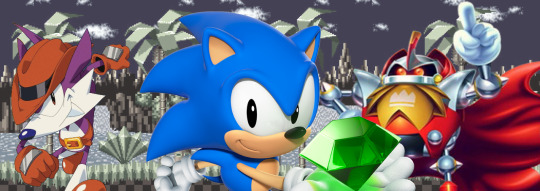
(In case you're stupid, this is an opinion piece made for discussion)
Greetings, boys and goyles. I'm Benis, otherwise known as Benis Chillin, Sonic lore enthusiast and fanfic writer. I say the latter part because I want people to know that I'm well aware that many of my criticisms are based in the fact that I'm a writer, and unlike most people, I try to run more by objective canon than my whims. I explain it more here.
And per those standards…The current state of Classic Sonic SUCKS.
Now, I am a Modern Sonic fan through and through. I LIKED the 4 main Classic games when I played through them, but Sonic Adventure was the one that truly hooked me in. The world established by that game, and the ones that followed, just have my interest more, and I would prefer things be made in service to THAT.

However, to the greater detriment of society, Sonic Generations happened, and Classic Sonic was reestablished as part of the brand after years of Modern Sonic being THE face of everything, with even collections of Classic games using Modern Sonic artwork. And with the environment of the internet in the 2010's, it's no surprise that they decided to let Classic be its own sort of "brand" with Sonic Mania(bleh)and Forces(less bleh).
But they had a fun spin on it: A split timeline.
youtube
As explained above, Classic Sonic was given his own little mini-continuity to run around in, which is actually a brilliant idea, from a brand perspective. Original Classic Sonic had the creative freedom to do whatever the heck he wanted to, since he was the main Sonic. However, new Classic material, or Neo-Classic material, as I shall now refer to it, if left in the main timeline, inherently has the “prequel” problem where things HAVE to have some kind of hook for it to really be worth having another branch of the brand available. I wouldn’t say EVERY brand has this problem, but even the most masterful uses of that format have to deal with the fact that the future is predetermined, and Neo-Classic Sonic material just does not have the leg room to work around that problem.
So, split the timeline, and just do whatever with it. It’s an AU, go nuts! Let a part of the brand reset and grow in a different way for that audience who isn’t into that Modern stuff!
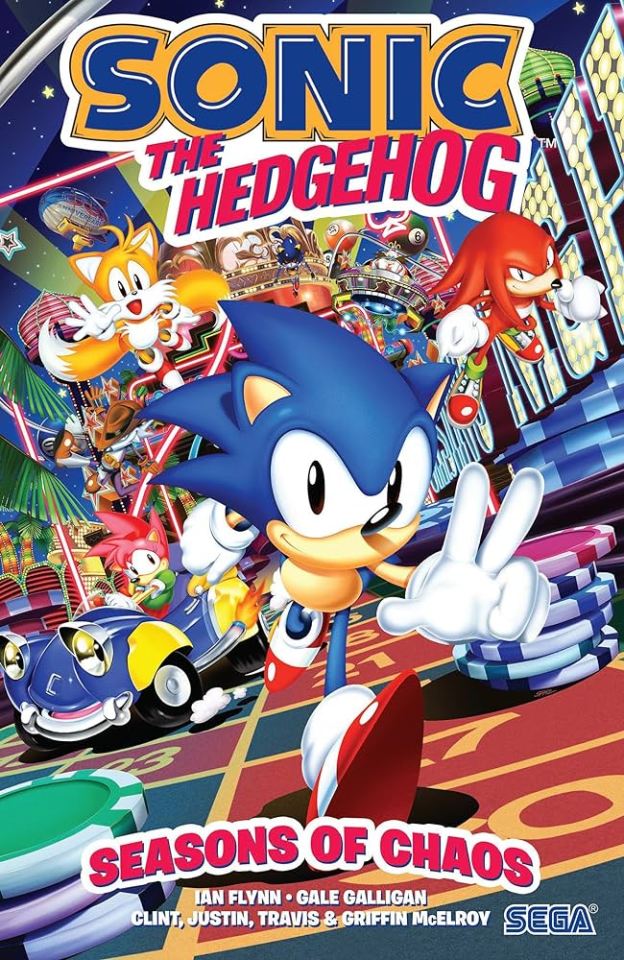
And we had a promising enough start with the 30th anniversary comics! Full of interesting returns that you didn’t really see in the mainline books. Heck, we got an actual look at the design of Metal Knuckles, that was pretty rad!
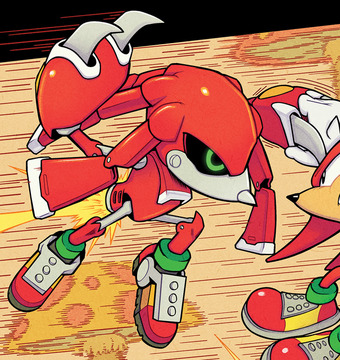
Bark, Bean, and Fang also had an appearance that made their old Archie team somewhat canon, after they only appeared as illusions in Mania. Sure, these characters were neat in the Archie comics, but getting a proper form of that in a continuity free of that Satam Stank was nice. This particular comic being a separate thing from my main love, while not diving into the weird stuff that would turn me off from it, inherently made the comic more interesting, even though I’m not much of a Classic Sonic fan.

And so this sentiment continued through the next specials, but something else began to shift on Sega’s side. The dumbassery of single timeline was stated to be the new status quo, and they started acting as such with new Sonic material.
Sonic Superstars came out, too, and my feelings on that are known. Now, after his appearance in the comics had been a bit of a treat, even if you didn't like him, Fang was in an official Sonic game again, with 3D renders to boot!
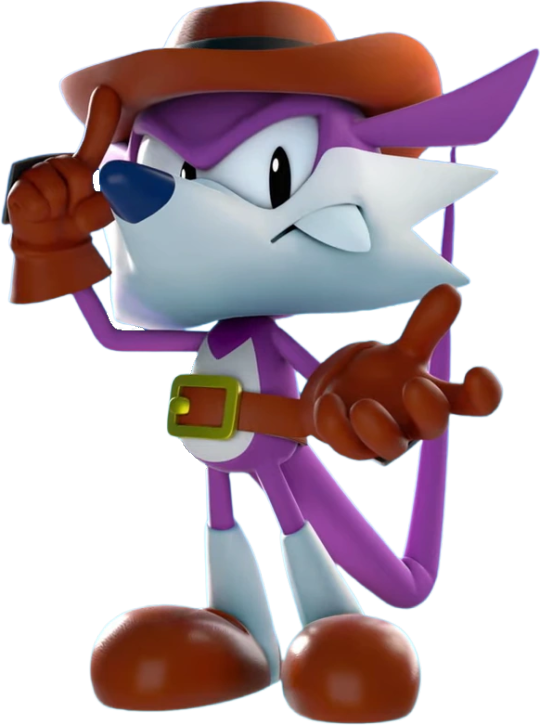
...But he was still the same jackass with barely any personality that he was before. Because Superstars was TRYING to be like 3&K with its storytelling, while lacking basically every element that made 3&K's storytelling work. Combine the lackluster story and music, both of which were caused by the idea of it being a Neo-Classic game, with the fact that the graphics were 3D, and now the question is being raised of, "Why wasn't this just a Modern Sonic game?"
Cause from an outsider's perspective, it being a Neo-Classic game only served to hold it back in a ton of ways!
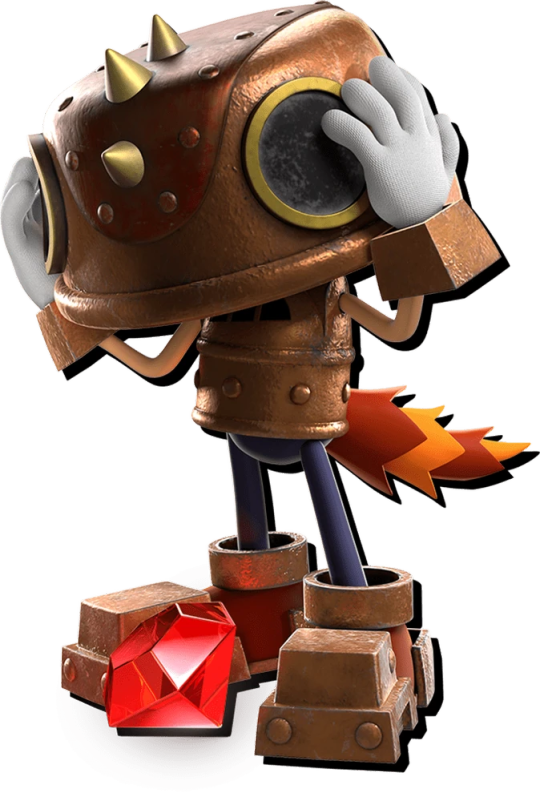
For example, the character of Trip. She seems well liked in the Sonic fanbase, but Sega's kinda funky with how they handle characters being both Classic and Modern. Sonic, Tails, Knuckles, Amy, Eggman, and Metal Sonic seem to be allowed to exist in both parts of the brand, but that's it.
Knuckles Chaotix is said to be canon, but the Classic Chaotix are unlikely to appear anytime soon since Sonic Heroes soft-rebooted them. Mecha Sonic was allowed to appear in the Modern "Scrapnik Island" mini-series, but I suspect it's seen by Sega as a "modern reboot" rather than a character being allowed to co-exist between the two brands again. Heck, they didn't even have the guts to show the Classic versions of the characters during the flashbacks, even though logically, they were still referencing 3&K.
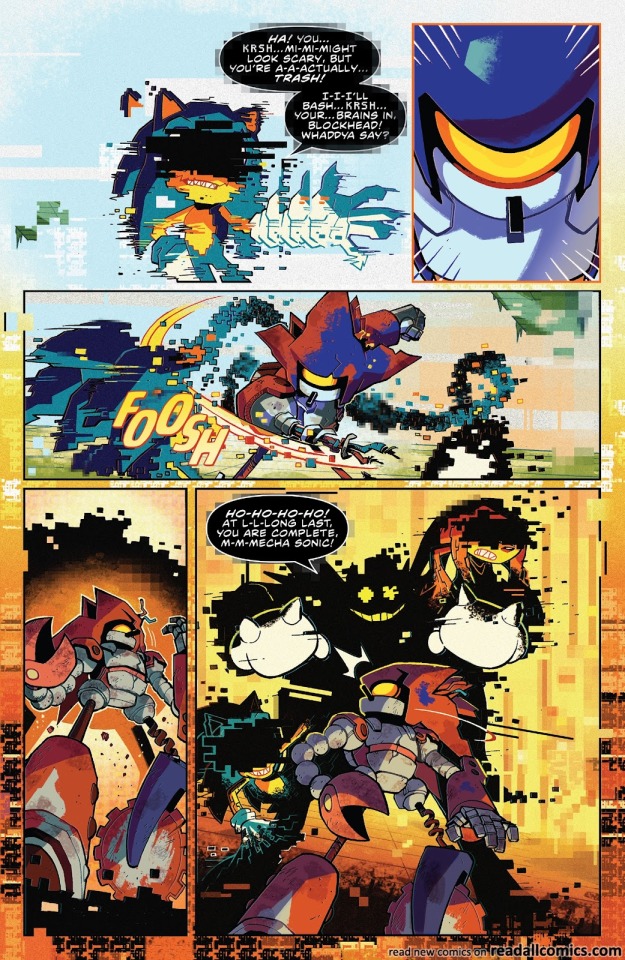
So will Trip be allowed to appear in any meaningful way in the future? Probably not, the way things have been going.
So, if all Classic characters can only appear in Neo-Classic material, then the Neo-Classic material has to be as good as it can be, right?
Well, that's where the Fang mini comes in.
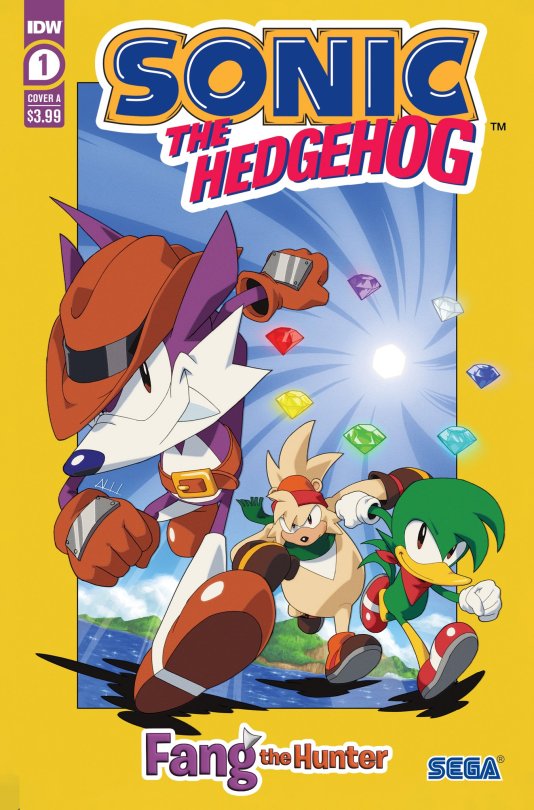
Written by Ian Flynn, who has very much been showing how utterly stretched he is across so many Sonic projects lately(even if I would still regard him as a fairly decent writer, just...Has his limits), the Fang mini is the epitome of BORING!
The basic story is that Fang and his gang are seeking out, "The eighth Chaos Emerald," visit a few people who tell him it doesn't exist, and then Eggman sends him to deal with the Hardboiled Heavies going rogue.
Along the way, Fang is just randomly a dick to his friends, and they end up abandoning his ass at the end because this comic is, for some reason, a direct prequel to Sonic Superstars, and we apparently needed an explanation of why they weren't there?
If my summary didn't sound that bad to you, it's because you don't have to go through the grueling wait that being an IDW Sonic fan entails.
Seriously, the wait between issues of IDW Sonic has become a real problem the past few years. Ever since the Metal Virus ended, the main book has had a massive problem with pacing.
And sure, there are arcs and ideas I like there, I AM a fan, but not a lot HAPPENS in each issue compared to earlier in the book's run. Even re-reading them, the pace is oddly slow for a book about a fast character, and the issue especially persists here...On top of the main book being paused for a bit so THIS shit could come out.
(Current arc is doing better, though, so hope they keep that up)
Issues 1&2 are wasted with Fang harassing Sonic and Knuckles for a bit that, guess what? Goes nowhere! And then we briefly divert to Fang and co. in a watery old Eggbase so Eggman can capture them and actually get the plot going…3 issues into a 4-issue mini! Then, we finally get to the main event, where all will be revealed! And…

It's the Warp Topaz from the main book. The Hardboiled Heavies found it in a cave, where nobody ELSE knew it was, so it can't be the source of the 8th Chaos Emerald rumors.
Like I told ya, that went NOWHERE!
So they fight the bland-as-shit Heavies, Fang adds the Warp Topaz to his hover bike thing, and the airship is wrecked, leaving Sonic and Tails to have no idea what just happened, their involvement being a complete wash.
And our story ends with Bark and Bean rocketing off in little hovercars that just raise the question of why they didn't use those when Fang threatened to kick them off in Issue 2, since he has no say in whether or not they launch.
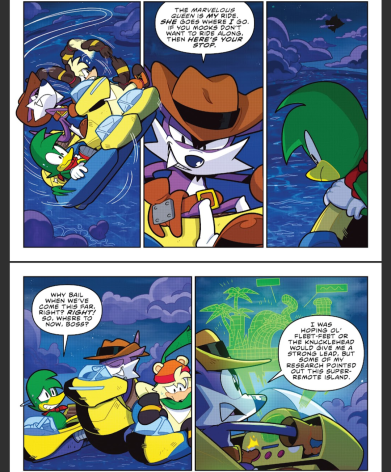

I actually managed to ask Ian Flynn about this on the Bumblekast, and this was his response:
youtube
Worth noting that the final issue has an additional editor that didn't work on the previous issues. Not saying EVERYONE'S blameless in this, but if I had to choose a weak point…
This mini-series encapsulates every little issue the Neo-Classic line has had since they officially eschewed split timeline.
It feels the need to go out of its way to explain shit that doesn’t matter, like where Bark and Bean were during Superstars, Fang having the Warp Topaz, but not using it during Superstars creates a gaping plot hole that will not wash away, and it not going away at the end brings up a lot of timeline issues that I can only hope that Knuckles special resolves!

In fact, why didn’t HE get the mini!?
Even in his Classic state, Knuckles has a LOT more to carry a story with! From the secrets of his island, to the mysteries of his people(which Adventure and the Frontiers promo animation hinted at), to even just doing his own treasure hunts! Heck, you could even pin him against both Fang’s crew and the HBH, and you’ve got enough of a banger to hold 4 action-packed issues right there!
But no! Instead, we get a book that seems written to depend on the personalities of the protagonists…When said protagonists barely have any personality.

Like, let’s consider Team Chaotix from Sonic Heroes ALONE. Vector is the loud, bombastic leader with a love of music, and true detective skills, as showcased by him figuring out that their employer was Eggman on his own by Rail Canyon. Espio is the disciplined, if a bit full of himself, ninja, taking down the bad guys with stealth and precision, while also being somewhat melodramatic. And Charmy is the excitable ADHD kid of the group who may occasionally want to go off-track and play around in the giant casino area.
These characters are simple, yet so full of personality that you immediately like them(unless you’re a 2010’s YouTuber). THESE guys can hold a narrative.
By comparison, what do Fang’s gang have after 3 comic appearances and Sonic Superstars?

Fang is a hired goon who has goons, Bean is “funny” bomb man, and Bark is the silent strong guy with a soft spot.
That is really it.
And this was FINE back when they were still in “Sega forgot us” territory. Being obscure oddities that we would rarely get in stories actually did a lot of heavy lifting for their more limited personalities. Despite what the current writers seem to feel about such limits, judging by Silver and Blaze's current "vacations" in the main book, characters being rarer can actually endear you to them.
But now, these guys aren't really that rare. In fact, I’d say they’re about equal to Team Chaotix in terms of mass media exposure within the past 5 years, and they’re considerably lacking in comparison.
Hell, even compared to the characters created RECENTLY in IDW and the Modern games, they're pretty lackluster. Yet I'm supposed to care about these assholes just as much as those guys?
Which, really, is how ALL of the Neo-Classic media feels these days.
Look, I get that Neo-Classic Sonic media doesn’t want to step on the toes of Modern Sonic. I do. But I really think it needs a good shake-up.
Quit treating it like it’s this special thing, because it isn’t anymore. Find a more solid identity for this branch of Sonic if you want it to survive, cause THIS doesn’t cut it anymore.
AND ACKNOWLEDGE THAT TIMELINE SPLIT ESTABLISHED IN A MAINLINE GAME, DAMNIT! THERE’S A STORY IN UNDOING THAT! TELL IT, OR I WILL!
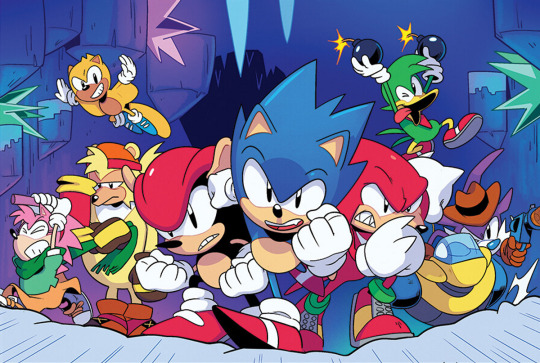
#sonic the hedgehog#idw sonic#sonic idw#sonic lore#classic sonic#fang the hunter#fang the sniper#restore the sonic neoclassic timeline#Youtube
27 notes
·
View notes
Photo

The timeless allure of preppy fashion is making a comeback with a modern twist! From traditional styles to 'neo-prep', today's look blends classic elements with contemporary trends. We're seeing a revival of mid-length skirt suits, collegiate sweaters, and iconic argyle patterns from top luxury houses to high street brands.
Fancy elevating your wardrobe with some old-money chic? Which preppy piece would you add to your collection first?
Share your thoughts below and tag a friend who'd rock this style! 👔👗
7 notes
·
View notes
Text
A walk through Bengal's architecture
Bengali architecture has a long and rich history, fusing indigenous elements from the Indian subcontinent with influences from other areas of the world. Present-day Bengal architecture includes the nation of Bangladesh as well as the Indian states of West Bengal, Tripura, and Assam's Barak Valley. West Bengal’s architecture is an amalgamation of ancient urban architecture, religious architecture, rural vernacular architecture, colonial townhouses and country houses, and modern urban styles. Bengal architecture is the architecture of Wind, Water, and Clay. The Pala Empire (750–1120), which was founded in Bengal and was the final Buddhist imperial force on the Indian subcontinent, saw the apex of ancient Bengali architecture. The majority of donations went to Buddhist stupas, temples, and viharas. Southeast Asian and Tibetan architecture was influenced by Pala architecture. The Grand Vihara of Somapura, which is now a UNESCO World Heritage Site, was the most well-known structure erected by the Pala rulers.

The Grand Vihara of Somapura
According to historians, the builders of Angkor Wat in Cambodia may have taken inspiration from Somapura. Bengal architecture became known for its use of terracotta due to the scarcity of stone in the area. Clay from the Bengal Delta was used to make bricks.
The temple architecture has distinct features like the rich wall decoration, often known as the terracotta temples, which was one of the remarkable elements of Bengali temple architecture. The double-roofed architecture of thatched huts was replicated by Bengali temples. Square platforms were used to construct the temples. Burnt brick panels with figures in geometric patterns or substantial sculptural compositions served as the temples' adornment.

Dochala style
These served as models for many temples that were built in undivided Bengal. Construction materials used in ancient times included wood and bamboo. Bengal has alluvial soil, so there isn't a lot of stone there. The bricks that were utilized to build the architectural components were made from stone, wood, black salt, and granite. Bengal has two different types of temples: the Rekha type, which is smooth or ridged curvilinear, and the Bhadra form, which has horizontal tiers that gradually get smaller and is made up of the amalaka sila. Mughal architecture, including forts, havelis, gardens, caravanserais, hammams, and fountains, spread throughout the area during the Mughal era in Bengal. Mosques built by the Mughals in Bengal also took on a distinctive regional look. The two major centers of Mughal architecture were Dhaka and Murshidabad. The do-chala roof custom from North India was imitated by the Mughals.

Jorasako thakurbari
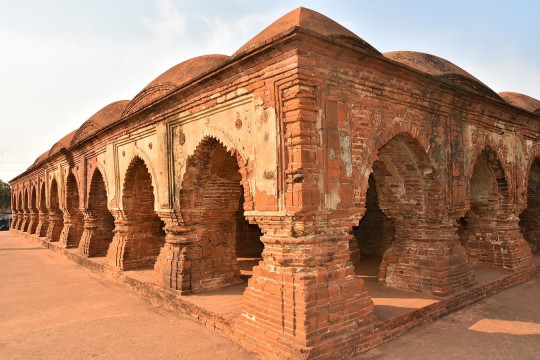
The Rasmancha is a heritage building located at Bishnupur, Bankura district, West Bengal.
Influence of the world on Bengal architecture: Although the Indo-Saracenic architectural style predominated in the area, Neo-Classical buildings from Europe were also present, particularly in or close to trading centers. While the majority of country estates had a stately country house, Calcutta, Dacca, Panam, and Chittagong all had extensive 19th and early 20th-century urban architecture that was equivalent to that of London, Sydney, or other British Empire towns. Calcutta experienced the onset of art deco in the 1930s. Indo-Saracenic architecture can be seen in Ahsan Manzil and Curzon Hall in Dhaka, Chittagong Court Building in Chittagong, and Hazarduari Palace in Murshidabad.

Hazarduari Palace in Murshidabad
The Victoria Memorial in Kolkata, designed by Vincent Esch also has Indo-Saracenic features, possibly inspired by the Taj Mahal. Additionally, Kolkata's bungalows, which are being demolished to make way for high-rise structures, have elements of art deco. The 1950s in Chittagong saw a continuation of Art Deco influences. The Bengali modernist movement, spearheaded by Muzharul Islam, was centered in East Pakistan. In the 1960s, many well-known international architects, such as Louis Kahn, Richard Neutra, Stanley Tigerman, Paul Rudolph, Robert Boughey, and Konstantinos Doxiadis, worked in the area.

The Jatiyo Sangshad Bhaban
This iconic piece of contemporary Bangladeshi architecture, was created by Louis Kahn. Midsized skyscrapers dominate the cityscapes of contemporary Bengali cities, which are frequently referred to as "concrete jungles." With well-known architects like Rafiq Azam, architecture services play a key role in the urban economies of the area. Overall Bengal architecture was influenced by various contemporaries of their time and continues to evolve.

Gothic architectural style seen in St. Paul's Cathedral in Kolkata.

Zamindar era buildings in ruin.

Belur Math in Howrah
#bengali#bangla#west bengal#bangladesh#tripura#assam#desi#বাংলা#india#architecture#tales#bengal architecture#history#kolkata#international#technology#information#temple#asia#bricks
193 notes
·
View notes
Text
The Myth of the Rational Actor
Ko-fi prompt from @vincentursus:
the myth of the rational actor please?
The myth as such: people will act in a perfectly rational manner, and the economy will respond in reaction to that.
So... the idea here is that emotions will never influence someone's actions in making economic choices.
Which is, as we can guess, bullshit.
To quote Medium,
Mainstream (neo-classical) economics idealizes human beings as perfectly rational actors when it comes to making decisions. This concept, known as rational choice theory, is based on three assumptions: 1. People have complete and consistent preferences (which can be assigned quantitative values called utilities) among a set of decision outcomes 2. People act independently based on full and relevant information 3. People always select the decision option that maximizes their utility.
So. That's absurd. Let's start from the bottom, utility.
One of the first things you learn in any marketing class is that half the industry is run on an appeal to emotion.
(The other half of it actually is an appeal to logic, like 'you can use this tool to compare your insurance costs,' which is the aforementioned rational action.)
The most obvious example of that utility element being wrong is: Food.
For a completely rational actor, the food purchased would be the most nutrition for the least cost. Taste is irrelevant. Ambience is irrelevant. Occasion is irrelevant. You fill out the food pyramid for whatever you can pay the least amount of cash. Buy a fifty pound bag of rice, wholesale canned tuna, and frozen veggie mixes that you only need five minutes to heat up and consume.
Chocolate? No. Salt or sugar? Only enough to fulfill your need for water absorption. Spices? Waste of money!
This sounds extreme, because a complete lack of emotional impact on your purchasing habits is extreme. You seek things that make you happy or pleased. You search for sweet tastes that cheer you up, for fatty tastes that satisfy you, for spicy flavors that you can eat in a competition with your friends to prove who's the manliest.
That's not rational! But we do it! Food is an inherently irrational thing to purchase, unless you are so strapped for cash that you cannot afford to be anything other than fully dedicated to the highest calorie:dollar ratio that you can find.
The other thing that the utility factor disregards is charity. On the standard 'rational' definition used in economics, charity is completely irrational for anyone who doesn't get a tax cut from it.
But people engage in charitable actions and donations anyway.
Full and relevant information: Uhhhhh no
I think we can all agree that full and relevant information is not actually a reality for most people.
Manufacturers bend the truth. Marketers omit things. Word of mouth is unreliable. Influencers lie. Online reviews are fake.
Some don't! But you don't know who is or isn't lying unless there is a law that controls what information they can put out. Researching takes time, and figuring out which lies are actually lies is difficult.
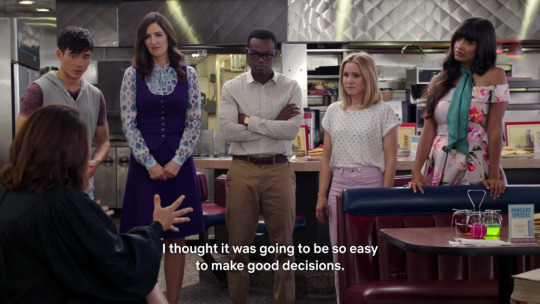
There are a lot of videos all over YouTube talking about scams, both the obvious, and the more subtle. There's a reason that misinformation is such a huge industry these days, and hey! A lot of misinformation relies on those aforementioned appeals to emotion that are both a marketing device and a rhetorical one.
Complete and consistent preferences: Sometimes?
I mean, some people have complete and consistent preferences. I have a favorite Starbucks drink that I get most times (technically I have four and it depends on the weather). I have stylistic preferences for my clothing. I have musical preferences.
But it still takes me time to make decisions when at a restaurant, you know? My little sister likes a lot of foods, sure, but if you ask her to pick a place to eat it can take literal hours. Hell, there are entire phenomenons named after the fact that people don't have preferences and have trouble making decisions!
And on top of all that, you have people whose 'preference' is spontaneity. They pick whatever they haven't tried before, because it's new, and exciting, and that's cool!
Which really harshes the mellow on that whole "clear and consistent preferences" thing.
Where does that leave us?
Well, the rational actor is clearly a majorly inaccurate standard to hold individual consumers and the market to. That said, I don't think more than a handful of very extreme people would ever claim that the rational actor is an absolutely perfect predictor for the market.
Rather, it's used as a starting point. If the market reacts to forces in a completely rational manner, here is what we would be expecting. Then, upon projecting the actions of the market under the most rational and perfect conditions, we can apply other possible factors. The possible success of a marketing campaign. The risks of weather or politics impacting supply lines. An unexpected trend rising up from a comedic social media moment among teens and young people.
Imagine you have a catapult. Imagine you know what the catapult will do under perfect conditions, with consistent rope length and artillery weight and weather conditions. The numbers you run your basic physics class formulas with are the rational actor.
The market trends that cause that rational prediction to have error margins is the equivalent of "the wind's been varying between 3mph and 9mph, and from NW to SWW."
I'm not sure how safely I can get away with embedding images that I don't personally have the rights to when they're actually relevant to the education portion of this, and not just a silly joke like the TGP inclusion up there, so I'll just tell you to go look at the first graph at this link, and you'll see what I mean about the 'best, most predictable case' line vs the 'actual possibilities' forecast.
Hope that helps!
(If you wanted me to go more into the history of this concept than its actual uses, uh... whoops?)
#economics#economic forecasts#capitalism#phoenix talks#ko fi#ko fi prompts#research#rational actor#myth of the rational actor
101 notes
·
View notes